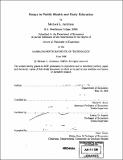| dc.contributor.advisor | David H. Autor and Joshua D. Angrist. | en_US |
| dc.contributor.author | Anderson, Michael L., Ph. D. Massachusetts Institute of Technology | en_US |
| dc.contributor.other | Massachusetts Institute of Technology. Dept. of Economics. | en_US |
| dc.date.accessioned | 2006-11-07T12:36:40Z | |
| dc.date.available | 2006-11-07T12:36:40Z | |
| dc.date.copyright | 2006 | en_US |
| dc.date.issued | 2006 | en_US |
| dc.identifier.uri | http://hdl.handle.net/1721.1/34507 | |
| dc.description | Thesis (Ph. D.)--Massachusetts Institute of Technology, Dept. of Economics, 2006. | en_US |
| dc.description | Includes bibliographical references. | en_US |
| dc.description.abstract | This thesis studies the long-term benefits of preschool interventions, the impact of promotions on heart disease, and the effects of light trucks on traffic fatalities. The first chapter examines the long-term effects of preschool interventions. Several influential experiments - Abecedarian, Perry, and Early Training - have convinced many economists that preschool interventions have super-normal returns. This chapter implements a unified statistical framework to present a de novo analysis of these experiments, focusing on core issues that received little attention in previous analyses: treatment effect heterogeneity by gender and over-rejection of the null hypothesis due to multiple inference. The primary finding of this reanalysis is that girls garnered substantial short- and long-term benefits from the interventions. However, there were no significant long-term benefits for boys. These conclusions change little when allowance is made for attrition and possible violations of random assignment. The second chapter, coauthored with Sir Michael Marmot, investigates the effect of promotions on heart disease. The positive cross-sectional relationship between socioeconomic status and health is well documented, but little evidence exists regarding the causal effect of social status on health. | en_US |
| dc.description.abstract | (cont.) This chapter uses data on British civil servants from the Whitehall II study. It identifies differences in departmental promotion rates as a plausibly exogenous source of variation in promotion opportunities and exploits this variation to estimate the causal effect of promotions on heart disease. The results suggest that promotions can reduce the probability of heart disease by 3 to 13 percentage points over a 15 year period. The third chapter analyzes the traffic safety impact of the increasing popularity of light trucks. It combines estimates from a state-level panel data set with an accident-level micro data set. The results suggest that a one percentage point increase in light truck share raises annual traffic fatalities by 0.41 percent, or 172 deaths per year. Of this increase, approximately one-quarter to one-third accrue to the light trucks' own occupants, and the remaining two-thirds to three-quarters accrue to other roadway users. Using standard value of life figures, the implied Pigovian tax is approximately 4,650 dollars per light truck sold. | en_US |
| dc.description.statementofresponsibility | by Michael L. Anderson. | en_US |
| dc.format.extent | 119 p. | en_US |
| dc.format.extent | 7460149 bytes | |
| dc.format.extent | 7465099 bytes | |
| dc.format.mimetype | application/pdf | |
| dc.format.mimetype | application/pdf | |
| dc.language.iso | eng | en_US |
| dc.publisher | Massachusetts Institute of Technology | en_US |
| dc.rights | M.I.T. theses are protected by copyright. They may be viewed from this source for any purpose, but reproduction or distribution in any format is prohibited without written permission. See provided URL for inquiries about permission. | en_US |
| dc.rights.uri | http://dspace.mit.edu/handle/1721.1/7582 | |
| dc.subject | Economics. | en_US |
| dc.title | Essays in public health and early education | en_US |
| dc.type | Thesis | en_US |
| dc.description.degree | Ph.D. | en_US |
| dc.contributor.department | Massachusetts Institute of Technology. Department of Economics | |
| dc.identifier.oclc | 70889247 | en_US |
